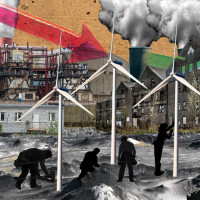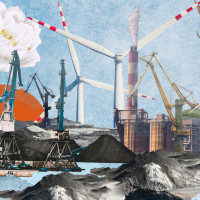Common findings — From private profiteering to public energy transitioning
Topics
The energy transition requires planning and coordination across scales. This calls for reclaiming energy from the market and collaboration between public utilities, communities and governments at every level. A revitalised and democratised public sector can lead the way.

Introduction
Common findings: From private profiteering to public energy transitioning
Listen to the bombastic forecasts and glittering commentary coming from dominant energy industry actors and you might find yourself breathing a sigh of relief. ‘The outlook for low-carbon transition continues to look extremely bright,’ according to Bloomberg New Energy Finance, who reported that global investment in low-carbon energy technologies bypassed $1 trillion last year.1
Private investors and liberalised markets, we are told, are paving the way to a clean energy future. Industry commentators point to falling renewables costs as evidence that fossil fuels will soon become a thing of the past. So long as investors are protected through intellectual property rights and trade and investment agreements, capital will flow seamlessly into the energy transition. Governments, apparently, can sit back as power is decentralised through small-scale renewable projects and the rise of the ‘prosumer’, with individuals becoming energy producers as well as consumers.
Unfortunately, these optimistic claims cannot be taken at face value. In fact, what is at play here is a series of dangerous myths – myths that threaten to further consolidate inaction and injustice. It’s difficult to see how anyone can describe the state of the energy transition as anything approximating ‘bright’ when coal, oil and gas consumption continues to increase. Fossil fuels still account for 82 per cent of total primary energy consumption worldwide.2 Global coal use in late 2022 was at a record high.3 A 2021 International Energy Agency (IEA) study suggested that global oil consumption for 2022 would be an average of 2.1 million barrels per day higher than 2021. This figure is projected to rise by a further 2.1 million barrels per day in 2023.4
Yes, investment in renewables is growing -- but nowhere near fast enough. The rate of growth for new renewable energy deployment halved between 2016–2021.5 Global renewable energy investment reached a record high of $0.5 trillion in 2022 -- less than one third of the average annual investment needed between 2023 and 2030, if we are to meet the globally agreed target to limit warming to 1.5°C above pre-industrial levels.6 In mid-2023, the IEA’s assessment was that only three of the fifty components of the energy transition are fully on track.7
In sum, the energy transition is in serious trouble. Further, where progress is being made, the dominant pro-private and pro-market narrative gets things drastically wrong once again. Public funding rather than private investment has been the key driver of transition so far: 60 per cent of total climate finance globally was accounted for by public funds (including households) in 2019/2020.8 Contrary to neoliberal ideology – according to which the public sector is ‘risk averse’ and the private sector is ‘innovative’ – public institutions are more likely to fund higher-risk transition sectors, with the public sector leading on technologies further away from commercialisation such as tidal and wave energy or thermal storage.9
Indeed, the vast majority of private investment in the energy transition is highly dependent upon public subsidies. When governments leading on the energy transition such as Germany and China dropped their ‘Feed-in Tariff’ renewables subsidies, the consequences were dramatic. In Germany, investments in renewables dropped by 46 per cent in 2015. And between 2017 and 2018, investments in clean energy in China reduced by 38 per cent (with investments in solar falling by 53 per cent).10
Might falling renewables costs change all this? Many argue that the cost of renewable energy is declining to such an extent that we will soon reach a ‘tipping point’ where renewable energy becomes cheaper than fossil fuels, after which investment patterns will shift substantially. While the unit cost of renewable energy is, indeed, declining, renewables price data tends to obscure the hidden costs of the infrastructural upgrades and changes required required to integrate renewables into the grid. These hidden costs will add an estimated 10–15 per cent to the price of a unit of energy, once renewables account for 25 per cent of total energy production11 – and will only increase as decarbonisation proceeds. What’s more, price is not the decisive factor shaping energy transition. The evidence – both historically and present day – shows that falling energy prices often undermine energy industry profits. In turn, falling renewable prices run the risk of detracting investors.12 Perhaps more importantly, they are premised upon continued labour exploitation within renewables supply chains, which are increasingly linked to forced labour and modern slavery.13
The profit-based model of energy transition, then, is plagued by contradictions and is failing on its own terms. It is also driving escalating inequality and injustice. One third of the world’s population currently lack access to reliable power. In 2021, an estimated 860 million people across the global South had no access to electricity, with an additional 1.1 billion having only intermittent electricity access.14 The situation in Europe is not all that different. Indeed, energy poverty doubled over a 10-year period across Europe during the period of energy liberalisation.15,16 Indeed, as noted by the IEA: ‘For the first time in decades, the number of people without access to electricity is set to increase in 2022.’17
How did we get here? The history of the market model boils down to a combination of ‘liberalise and subsidise’, since the growth in renewables has really taken place despite rather than through liberalisation.18 In fact, there has never really been a free market in renewable power, nor is there ever likely to be. Instead, the renewables sector has been propped up by public subsidies. These subsidies coexist with liberalisation policies, which have concentrated power in the hands of a few oligopolistic firms.
These firms are now facing a ‘death spiral’ as their costs grow and income falls. State-owned firms were discouraged or (like South Africa’s power utility Eskom) outright banned from investing in renewable generation. Instead, they had to prop up private investments, cover increasing grid costs and focus on recovering production and service costs at the expense of increasing people’s access to energy. With utilities increasingly under strain, some governments have started issuing ‘capacity payments’ to fossil fuel producers for providing supply of ‘baseload’ generation at all times in order to ensure security of supply.19 Here we see the liberalise and subsidise model in full swing. Governments are compensating for their lack of control over the energy sector by providing subsidies for all, green and filthy alike.
At the same time, this disastrous market model continues to be being propped up by a set of legal frameworks that compound the problem. Take Intellectual property (IP) laws, which assign firms exclusive rights to use, license, and profit from new innovations. Advocates claim that IP stimulates investment by protecting firms’ market share. The result, though, is a highly exclusionary system, which has limited the production of clean energy technologies to a handful of companies, largely in high-income countries.20 Of the top 10 wind turbine manufacturers globally, every single firm is located in Europe, the United States, or China.21 This global oligopoly of renewable production is one of the reasons why the whole African continent produces just 1.5 per cent of the world’s solar energy, despite having the greatest possible productive capacity.22, 23
Or consider Investor State Dispute Settlement (ISDS) mechanisms, which allow corporations to sue governments for policies that affect their profits. Investors argue that they need protection through ISDS to provide legal certainty and stability. In practice, this ‘protection’ amounts to a powerful weapon for the fossil fuel industry, who repeatedly sue governments for measures that seek to curb fossil fuel consumption. The Netherlands, for example, was sued twice for its plans to stop coal power production by 2030, with lawsuits pursuing a total of 2.4 billion euros in compensation.24
Investment protection also extends to renewable technology. For example, many ISDS lawsuits were initiated against Spain by so-called renewable investors but in reality the vast majority of the claimant were financial entities, not energy producers. Almost half of them also had investments in fossil fuels and nuclear energy, and many simply bought up existing installations because of above-market returns instead of expanding renewable production.25
Thus, the pro-private and pro-market solutions we are promised turn out to threaten deep losses for people and the climate. We need alternatives. For some, the answer is decentralisation of energy provision through the promotion of small-scale renewable initiatives. However, here lies another myth. Rooftop solar PV has the potential to meet an estimated 18 per cent of the EU’s electricity needs, yet only if every single rooftop in the region that is solar compatible has a PV system installed. Decentralised renewables are essential and have to be maximised but simply cannot cut it on their own.
Community energy schemes face substantive challenges when they are forced to compete in a for-profit market. In fact, serious questions can be raised about the democratic credentials of decentralised energy initiatives due to the risk of exclusivity. That’s why the focus should not be decentralisation but democratisation. As illustrated by Costa Rica’s integrated public power model which combines state, municipal and cooperative firms, we must increase accountability and effectively connect decentralised initiatives with larger-scale energy production – and vice versa – in order to achieve clean energy for all.
Ultimately, the energy transition requires planning and coordination across scales. This calls for reclaiming energy from the market and collaboration between public utilities, communities and governments at every level. A revitalised and democratised public sector can lead the way. This means public ownership of the energy sector with accountability and participation from energy sector workers and energy users.26 It means direct public investment in the energy transition, with a level of ambition and urgency proportionate to the scale of the crisis we face. And it means recognising energy’s role as a basic social need through a ‘Global Public Goods’ approach, which prioritises equity, justice and energy access over private profit.





